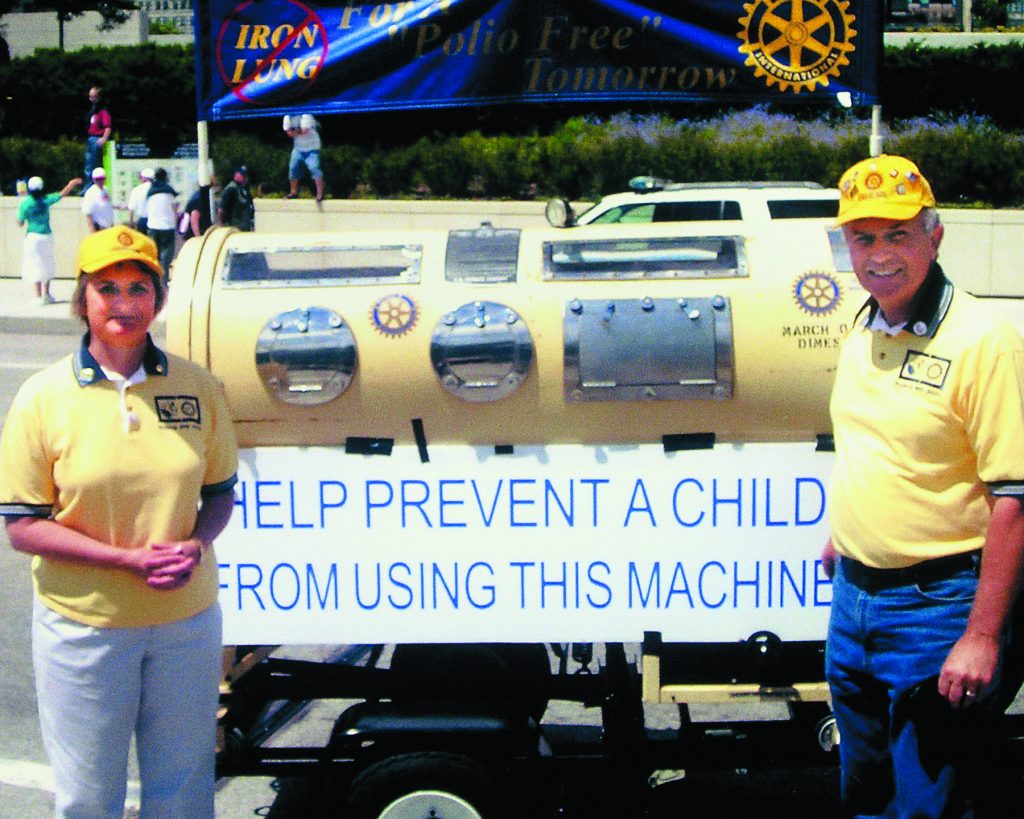
Nancy Edmonds Hanson
hansonnanc@gmail.com
When today’s grandparents were kids, summer was a time of dread. The villain: polio – contagious, mysterious and incurable. Today, it’s no more than an entry in the history books, thanks to a worldwide campaign that has all but eradicated one of the planet’s most feared diseases.
It’s a nearly unprecedented health success story, not just in the United States but around the world. But as disease fighters celebrate World Polio Day on Thursday, Oct. 24, the 30-year global war on the devastating virus is not quite won … and it’s not time, says Gary Nolte of Moorhead, to put away the weapon that’s leading to victory.
“There is no cure for polio. Vaccination is the only thing that works,” he says. A member of Moorhead Rotary, he chairs the district’s Polio Plus campaign. He and his wife Cindy, a registered nurse, have participated in Rotary International vaccination campaigns in Nigeria, India, Niger and Ghana.
When the Noltes and their friends were growing up in the 1950s, little was known about its causes. Panicky parents warned their children away from swimming pools and movie theaters. Treatment was primitive. There was no cure. In 1952, at the peak of the American epidemic, 58,000 people were infected. Most had only a few days of mild fever, but babies and children were most vulnerable to its darkest side – infection of the brain and nervous system, leading to paralysis of the arms, legs. The most serious cases lost the ability to breathe and survived only when encased in “iron lungs,” where alternating positive and negative air pressure brought breath in and out of their lungs.
Salvation began in 1955 when Jonas Salk introduced the first polio vaccine. Using dead polio virus, it was injected into the arms of millions of school children. A few years later, Albert Sabin’s alternative vaccine – infused with a greatly weakened strain of the disease – could be administered with drops on sugar cubes.
Vaccination worked. By 1979, America was declared polio-free. For much of the rest of the world, however, the campaign to vaccinate nearly every child has continued.
Immunologists now know that the disease spreads, not through direct contact or droplets in the air, but from the digestive system through contaminated water. The virus can live five days outside the human body, its only host. Nearly universal immunization is the only way to stop infection in its tracks.
Three slightly different strains have “trivalent” vaccine, with components to attack each variant. That’s changing, though, as nations have slowly approached universal vaccination. Two of them are nearly eliminated. “Type 2 was officially pronounced extinct in 2012,” Gary says. “Type 3 will probably be declared extinct soon, possible even later this week.
“But Type 1 – the worst – is still around in pockets where fighting has prevented us from entering, including Afghanistan and Pakistan. We still have work to do.”
Since the 1980s, however, the 1.2 million members of Rotary International have fueled a concerted battle to close those gaps. In the beginning, the virus was present in 125 countries and paralyzed 325,000 people every year. Rotary helped found the Global Polio Eradication Initiative in 1988, partnering with the World Health Organization, UNICEF, the U.S. Centers for Disease Control and (since 2000) the Bill and Melinda Gates Foundation. Rotary has raised and donated more than $1.5 billion since then to underwrite the effort. The Gates foundation matches every dollar raised with two of its own.
Rotary clubs around the world have worked to support Polio Plus for 31 years. Each goes about it in their own way. Fargo-Moorhead’s five clubs, for example, partner with the Recital with a Cause every April. The concerts spotlight the area’s most talented young musicians. Free-will offering have generated more than $100,000 in the ten years since the first was held.
Today, middle-aged and younger people know polio as little more than a curiosity – one of the childhood vaccinations recommended for every child. The CDC recommends kids get four doses of vaccine at four ages: 2 months, 4 months, 6 through 18 months, and 4 through 6 years.
While the chance of contracting the disease might seem remote to many, Gary and Cindy emphasize that the world has grown far smaller, and the risk remains.
“We know we can wipe it out if we can get access to the final frontiers where it is lurking,” Gary says. “But until then, it could be only an airplane ride away.”


